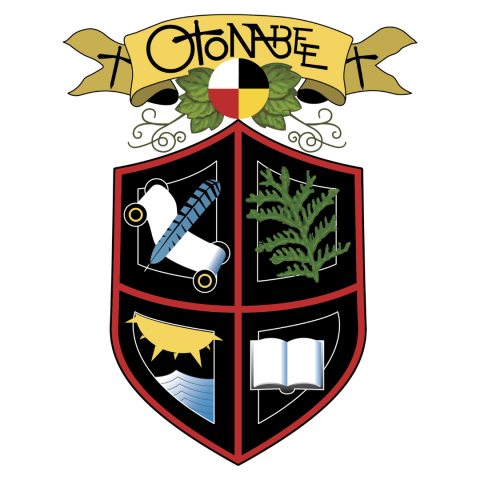
Crest
Proud to be Trent’s largest college, OC represents a diverse group of learners. Home to the Departments of Anthropology, Computing and Information Systems, Forensic Science, Psychology, Sociology, as well as the School of Education and the Trent-Fleming School of Nursing, Otonabee College members are learners, researchers, and practitioners.
This vibrant academic and collegiate community embraces a multi-disciplinary approach to programming, which empowers the Otonabee community in active learning, knowledge mobilization, and service-leadership.
Our motto, tempora mutantur nos et mutamur in illis (the times are changing and we change with them), reflects how the community is adaptable and impactful, like its namesake river.
The Otonabee College Crest
As part of the 20th anniversary of Otonabee College in 1993-94, the Head of the College at the time (Professor Gordon Johnston) announced that a college crest would be created to celebrate this milestone in the history of the College. A first version of the crest was unveiled by the next Head of the College (the late Professor Robert Annett) on the College's 25th anniversary in 1998. The crest was designed by an Otonabee student, Kevin Crellin, and much of the work needed to make this crest 'official' was masterfully undertaken by Brian Poirier (afterward President of the OC Cabinet). In 2003, Professor Ivana Elbl, who followed Professor Annett as Head, arranged with Richard Miller of Communications to update the design and make it available electronically. Various items bearing the College crest are now available from the College Office.
In the conventional design of a coat of arms, a helmet stands above the crest itself. In the Otonabee College crest, a quartered medicine circle replaces the helmet to honour the traditional teachings of the First Nations Peoples and also the historical relationship between the College and the Native Studies Department. According to Vern Douglas (Native Studies), the circle here has many different forms and meanings, including: the four cardinal directions, the cycle of the seasons, the cycle of human life, and the four human faculties. This particular form of the circle also represents the four races of the earth, and is hence a very appropriate way of recognizing both the intentional composition of the College and its relation to the earth as a whole.
In the shield itself, the four 'elements' express the identity of the College. The feather and scroll (upper left) and the open book (lower right) represent learning and scholarship in a general sense, but also contrast history and the present. We considered substituting the image of a computer screen for the book, but decided it would seem jarring or unrecognizable. The cedar branch (upper right) represents not only the cedar ridge on which the College is situated, but also the connections between the College and the environment more generally, especially the Environmental Studies program. Evergreen trees have also traditionally represented vitality and continuity, two important features of the College.
